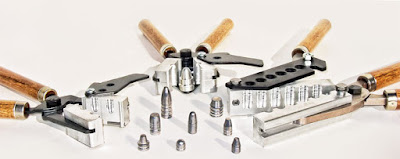With my 9mm mainstay caliber, I can put together rounds at around .10 per, which is roughly half the "all-in" cost of off-the-shelf bulk or "white-box" ammunition. I can also save around the same .10 each on .223/5.56 too as long as I'm good at picking components.
That's all the stuff, in this picture; powders, primers, and bullets. As it turns out, I can almost always find decent primers between $20 and $25 per 1000, which makes them about .02 ea. Pistol powder starts at about .01 per charge and tops out somewhere around .02 per, obviously not a real issue. Commercially purchased bullets range anywhere from .07 to .10 cents each. This basically adds up to anywhere from 10 cents to 14/15 cents per round for my 9mm loads. For .223/5.56, the powder charge is generally between 7 and 10 cents a round with the bullets starting at 11 up to around 15 cents ea.
It doesn't take a rocket scientist to tell that the bulk of the cost of reloading is in the bullets themselves. Sure, you'll cut off around 10 cents per round off of any reloaded ammunition, but in order to change the supplies figure much at all, you'll have to do something about the cost of bullets! How does one do that? There are actually more than one way:
- Buy them is big bulk lots of 5000 or more. This isn't much of an option for me since the is a hobby oriented toward to low end.
- Buy "pulls". These are literally what the name implies; where actual bullets are pulled from completed cartridges that either failed inspection or are contract over-runs etc. I might go this route as I learn more about them.
- Casting my own from lead. And this is obviously where this post is going....
I've always been interested in this off-shoot of an off-shoot part of the hobby. There is something about taking scrap and turning it into something useful that appeals to me. And that it's another kind of a "throw-back" skill interest me as well. Unfortunately, the downside is that at this point, it's a little late in the game to get into the process..... however, let me apply some history and analytics to the issue and show what I've learned.
Let me start here. At one time, aspiring bullet casters started by going to the friendly local tire shop and asking them for their buckets of scrap lead wheel weights. Then, they go home and get out an old cast iron pot, melt them down, skim off the dross (crud) and pour them out into ingots, which eventually ended up in a casting pot to be molded into bullets. Simple enough and all for about $0! Then this happened.
By executive order, then President Obama pretty much did away with the use of lead in virtually all aspects of the U.S., ......including the rather prosaic wheel weight.
These days, chasing down lead is something akin to some sort of post-apocalyptic scavenging. Anyway; enough on that rant. How does an aspiring bullet caster set about gathering some precious grey booty?
.....Uhhhh, eBay of course!!! Or even Etsy, but yeah. There are folks out there who have the time to go chase down the many tons of lead that's still out there and are happy to sell it to those of us who don't.
Let's look at the economics of it then. I did some calculations yesterday and here's what I found using a price of $1.50 per pound which I can find pretty easily (both locally and through the Internet)...
- Typical 115gr bullets used for 9mm Lugers like I shoot cost about .02 each to make.
- Typical 55gr bullets used for .223/5.56 "NATO" like my AR shoots are about .01 each.
- That's a savings of anywhere from 5 to 10 cents per round, which is like taking the savings from reloading (which is roughly half of commercial) and halving it again!
Is all this going to turn me into a crazed shooter, out every weekend doing mag-dumps in the woods? No, not really my style. However, when I do go shooting, the cost will be about as far down as I can make them. Sure, the current cost of ammunition is at an all-time low (inflation adjusted), but how long do you figure that's going to last? Till the next election maybe? For me, I'm going to be ready.
The two images above show the current state of my reloading bench. With the Lee Classic Turret press up and running and the Inline Fabrication's Case Ejector system installed, I can now easily crank out around 100 rounds in an hour. That's not anywhere close to the speed of "progressive" presses, but it's "cranking it out" in my world. What it really does though is shift the bottle-neck from speed of production to cost of components. Hopefully, that's something that bullet casting will resolve for me. I'll keep you posted.














No comments:
Post a Comment